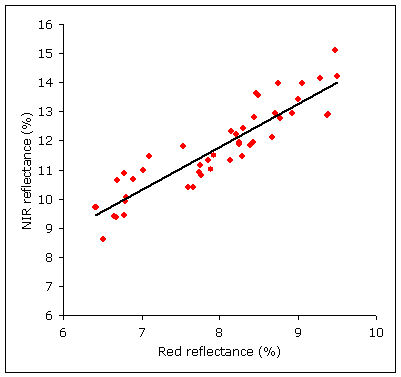Vegetation Indices
Soil line
Soil has a particular spectral signature that differentiates it from other land cover types. In the visible and near infrared region, reflectance increases in proportion to the wavelength increase. However, the rate of increase is affected by many factors. Soil texture and structure establish whether the soil reflects energy as a diffuse or Lambertian reflector. Soil moisture and organic matter increase soil absorbency and result in overall lower soil reflectance.
However, the relationship between red and near-infrared reflectance remains relatively constant for a specific soil type with particular characteristics. If we were to collect many spectral measurements of the same soil, under different moisture content conditions, and then plot the red against the near infrared reflectance for each measurement, we would get something like the following figure:

Because the reflectance between red and near infrared fluctuate proportionally, when the moisture content changes, those two values are said to be correlated and have a linear relationship. This means that whenever one changes, the other changes according to the relationship that binds the two. The line that describes that relationship is known as the soil line, which is unique for each soil.
Vegetation indices accounting for soil
The Perpendicular Vegetation Index (PVI) of Richardson and Wiegand (1977), used the red and near infrared bands to calculate the perpendicular distance between the vegetation spot on the NIR-Red scatterplot and the soil line. Since vegetation has higher near-infrared and lower red reflectance than the underlying soil, the vegetation spot will be on the top left corner of the scatterplot. As vegetation is increasing in density, the vegetation spot will be moving further towards the top left, away from the soil line.
The weakness of the PVI is the assumption that there will be only one type of soil beneath the vegetation. However, this is not always the case, as there are environments where a mixture of soil types (a mixture of soil and rocks for example) can be found within a very small area. Huete (1988) proposed the Soil-Adjusted Vegetation Index (SAVI) to deal with this problem. SAVI is a hybrid between a ratio index (NDVI) and a perpendicular index (PVI). Its formula resembles the former:
L is a correction factor and its value is dependent on the vegetation cover. For total vegetation cover it receives a value of zero, effectively turning SAVI into NDVI. For very low vegetation cover, it receives the value of 1. Huete (1988) suggested that the value of 0.5 is used when vegetation cover is unknown, as 0.5 represents intermediate vegetation cover.
Other indices, such as the Transformed Soil-Adjusted Vegetation Index (TSAVI; Baret and Guyot, 1991) and Modified Soil-Adjusted Vegetation Index (MSAVI; Qi et. al., 1994), followed similar rationale, but proposed different adjustment factors, that appeared to perform better than SAVI in certain cases. Additionally, specific vegetation indices have been proposed in the past, using high spectral resolution data (narrow bands) and looking specifically at chlorophyll and plant vigour. These include the Photochemical Reflectance Index (PRI) and the Normalised Pigment Chlorophyll Ratio Index (NPCI; Penuelas et. al., 1994), as well as the canopy chlorophyll content index (CCCI; Barnes et. al., 2000).
Question: Since plants are green, why aren't vegetation indices using green reflectance instead of red?
